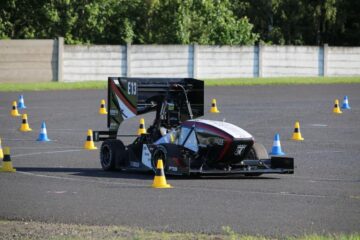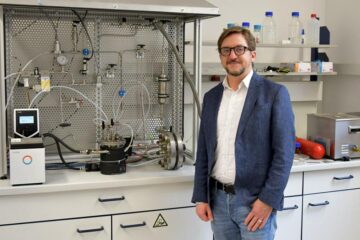Chemist breaks old barrier to better electron representation in molecular computations

Results apply to fields ranging from medicine to superconductivity
University of Chicago quantum chemist David Mazziotti has proposed a new research tool that could help scientists more rapidly solve problems in atmospheric chemistry, combustion, medicine and other areas of research where the behavior of electrons plays a key role. „We’re in the pioneering stage so we’re not going to go and treat all of these problems right away,“ said Mazziotti, an Assistant Professor in Chemistry. But with his new method, „we can do chemistry that cannot be done otherwise,“ he said.
Mazziotti explains his method in the Nov. 19 issue of Physical Review Letters. Further details will follow in early December in the Journal of Chemical Physics.
The key to understanding whether or not a particular chemical reaction will occur depends on a detailed statistical description of the electrons’ positions in the molecules involved. Until now, scientists have found it necessary to attempt to represent the motion of all the electrons in the molecule of interest-a daunting task requiring vast quantities of computer power. „Just a single water molecule has 10 electrons,“ Mazziotti said.
But in the 1950s, researchers theorized that it should be possible to accurately and more efficiently calculate the electronic properties of a molecule using only a pair of electrons representing many-even hundreds-of electrons in a molecular system. Mazziotti compares the feat to assembling a set of architectural blueprints, which represent in two dimensions a structure that can be built in three dimensions.
An architect follows certain rules to ensure that a builder can translate a two-dimensional sketch into a three-dimensional structure. „In the same way atoms and molecules consist of many electrons, but there is a way to represent all of the electrons rigorously with only two electrons. Certain rules have to be followed to ensure the two-electron ’sketch’ of the molecule accurately represents all the electrons in the atom or molecule,“ Mazziotti explained.
Mazziotti’s Physical Review Letters paper realizes a dream that scientists have pursued for 50 years by introducing a set of instructions for accurately and efficiently computing with a pair of electrons that represent the many electrons of the molecule. These instructions dramatically reduce the amount of computer time and memory required to compute the electronic properties of a molecule. Now Mazziotti can do some of the same calculations on his desktop computer that previously required Japan’s Earth Simulator, the world’s largest supercomputer.
„David has really made a huge contribution in turning the dreams of 50 years ago into useful tools,“ said Bob Erdahl, a professor of mathematics at Queens University in Kingston, Ontario. Erdahl said Mazziotti’s Physical Review Letters paper has applications to his own research in computing how behavior at the subatomic level brings about macroscopic changes in materials, such as the transition to the superconducting state. „I’m certainly going to look very closely and try to incorporate David’s latest innovation into my work. I think we will very quickly be able to beat other approaches in this area of solids and compute things that were out of reach before,“ Erdahl said.
Erdahl is especially interested in determining why superconductivity manifests itself only in two-dimensional layers rather than in three-dimensional solids. „The computations are of course very difficult to do. These methods that David is developing and that we’re developing are very helpful in attacking that problem.“ While Erdahl works in mathematical physics, understanding the electronic energies that atoms and molecules possess also affects almost every area of chemistry. One such area, Mazziotti said, has broad applications includes the chemistry of free radicals-highly reactive unpaired electrons.
In atmospheric chemistry, free radicals are instrumental in reactions leading to ozone depletion and the creation of greenhouse gases. Another area is the combustion of hydrocarbon fuels, which creates a variety of carbon-based radicals. „A lot of people want to know which radicals are present in a given combustion process and what reactions those were undergoing because that’s going to affect fuel efficiency,“ Mazziotti said.
A third area is medicine, because radical-type reactions are common in the human body. Mazziotti noted that hydroxy urea therapy combats sickle-cell anemia by forming a radical that triggers a cascade of additional reactions. „There is a 40 percent reduction in mortality for patients who receive hydroxy urea treatment for sickle cell,“ he said.
Despite the advances that Mazziotti and others have contributed to the representation of electrons in atoms and molecules, further advances could be in the offing. He said the field is experiencing a new wave of research. „We’re not done by any means.“
Media Contact
Weitere Informationen:
http://www.uchicago.eduAlle Nachrichten aus der Kategorie: Biowissenschaften Chemie
Der innovations-report bietet im Bereich der "Life Sciences" Berichte und Artikel über Anwendungen und wissenschaftliche Erkenntnisse der modernen Biologie, der Chemie und der Humanmedizin.
Unter anderem finden Sie Wissenswertes aus den Teilbereichen: Bakteriologie, Biochemie, Bionik, Bioinformatik, Biophysik, Biotechnologie, Genetik, Geobotanik, Humanbiologie, Meeresbiologie, Mikrobiologie, Molekularbiologie, Zellbiologie, Zoologie, Bioanorganische Chemie, Mikrochemie und Umweltchemie.
Neueste Beiträge

Ideen für die Zukunft
TU Berlin präsentiert sich vom 22. bis 26. April 2024 mit neun Projekten auf der Hannover Messe 2024. Die HANNOVER MESSE gilt als die Weltleitmesse der Industrie. Ihr diesjähriger Schwerpunkt…

Peptide auf interstellarem Eis
Dass einfache Peptide auf kosmischen Staubkörnern entstehen können, wurde vom Forschungsteam um Dr. Serge Krasnokutski vom Astrophysikalischen Labor des Max-Planck-Instituts für Astronomie an der Universität Jena bereits gezeigt. Bisher ging…

Wasserstoff-Produktion in der heimischen Garage
Forschungsteam der Frankfurt UAS entwickelt Prototyp für Privathaushalte: Förderzusage vom Land Hessen für 2. Projektphase. Wasserstoff als Energieträger der Zukunft ist nicht frei verfügbar, sondern muss aufwendig hergestellt werden. Das…





















